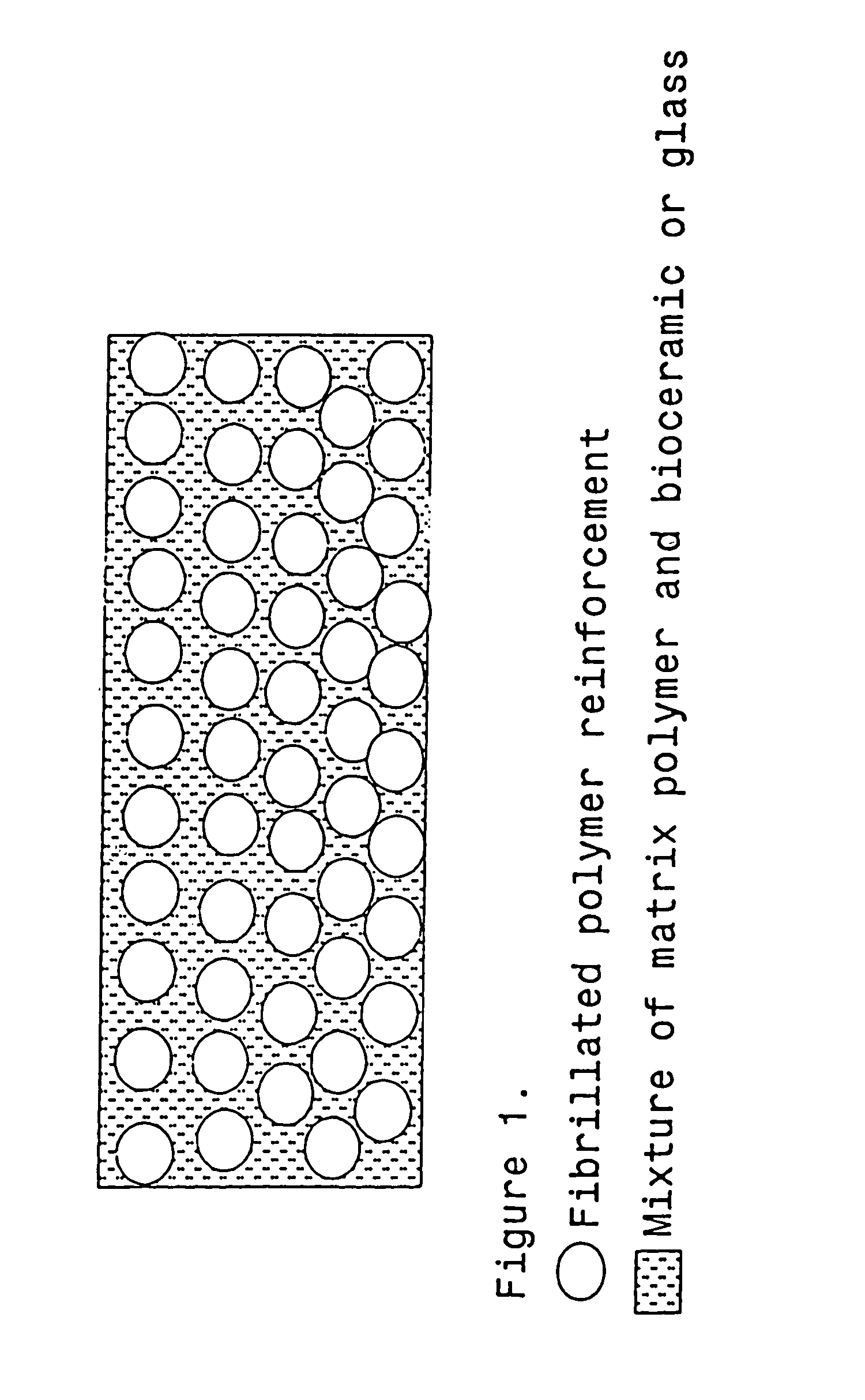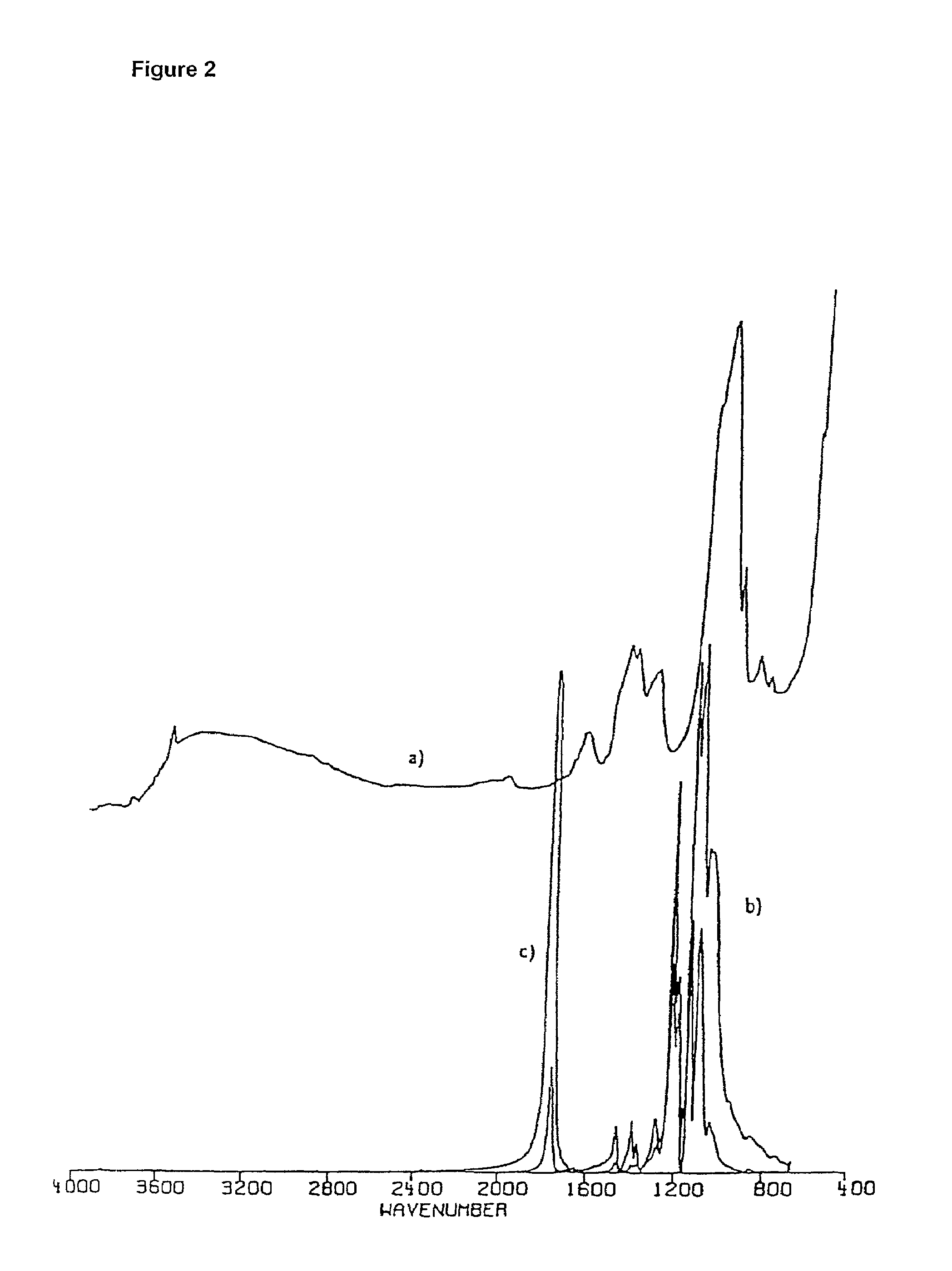Bioactive and biodegradable composites of polymers and ceramics or glasses and method to manufacture such composites
a technology of bioactive and biodegradable composites, which is applied in the field of surgical osteosynthesis composite materials, can solve problems affecting the bioactivity of devices, and achieve the effects of improving mechanical properties, insufficient strength, and lack of bioactivity of absorbable polymeric devices
- Summary
- Abstract
- Description
- Claims
- Application Information
AI Technical Summary
Benefits of technology
Problems solved by technology
Method used
Image
Examples
example 1
[0022]Plates sized approximately 50×10×2 mm were manufactured by compression molding from a powder mixture of poly (L,D-lactide) (95 / 5 L / D ratio) and hydroxyapatite with particle size of 60 μm, reinforced unidirectionally with poly (L-lactide) fibers (53 / 35 / 12 weight percent of matrix polymer-hydroxyapatite-polymer fiber, respectively). Three-point bending strength (yield) and modulus were 69.8 MPa and 5.8 GPa, respectively, and no sample fracture was detected (ductile behavior). These results were compared to the results of similarly sized samples without fiber reinforcement, compression molded from (1) plain PLDLA 95 / 5 and from (2) powder mixture of PLDLA 95 / 5 and hydroxyapatite (60 / 40 w / w %). These samples showed three-point bending strengths (maximum) and moduli of (1): 38.0 MPa and 3.9 GPa and (2): 26.8 MPa and 5.0 GPa, respectively. These samples broke in bending without yielding, thus showing brittle fracture behavior.
example 2
[0023]Plates sized as in example 1 were manufactured by compression molding from a mixture of poly (L,D-lactide) (85 / 15 L / D ratio) and hydroxyapatite with particle size of 60 μm reinforced unidirectionally with poly (L-lactide) fibers. Poly (L,D-lactide) and hydroxyapatite were previously melt mixed to a film form. The composition had 48 / 21 / 31 weight percent of matrix polymerhydroxyapatite-polymer fibers, respectively. Three-point bending strength (yield) and modulus were 116.6 MPa and 6.1 GPa, respectively, and no sample fracture was detected.
example 3
[0024]Plates sized approximately 50×10×1 mm were manufactured by compression molding from the unidirectional prepreg material of poly (L,D lactide) (85 / 15 L / D ratio), hydroxyapatite and poly (L-lactide) fibers. The proportions of components varied from 3-16 wt-%, 15-50 wt-% and 48-85 wt-%, respectively. Three-point bending strength (yield) and modulus depended on the concentrations of the composite. Typical mechanical properties are listed in Table 3. No sample fracture was detected and the behavior was ductile.
[0025]
TABLE 3PLDLAThree-pointThree-point(85 / 15)HydroxybendingbendingmatrixPLLA fibersapatitestrengthmodulus(wt-%)(wt-%)(wt-%)(MPa)(GPa)382151369.5471251439.15474814112.28613113910.5954371188.31648361669.6
PUM
| Property | Measurement | Unit |
|---|---|---|
| particle size | aaaaa | aaaaa |
| particle size | aaaaa | aaaaa |
| bending strengths | aaaaa | aaaaa |
Abstract
Description
Claims
Application Information
 Login to View More
Login to View More - R&D
- Intellectual Property
- Life Sciences
- Materials
- Tech Scout
- Unparalleled Data Quality
- Higher Quality Content
- 60% Fewer Hallucinations
Browse by: Latest US Patents, China's latest patents, Technical Efficacy Thesaurus, Application Domain, Technology Topic, Popular Technical Reports.
© 2025 PatSnap. All rights reserved.Legal|Privacy policy|Modern Slavery Act Transparency Statement|Sitemap|About US| Contact US: help@patsnap.com



